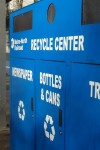September 2012 – Recycling Tip of the Month

Recycling is Great But Upcycling is Even Better
You know what recycling is, but have you ever heard of downcycling? No? Don’t worry, that’s a trick question.
Downcycling is just another name for recycling, taking used materials and products out of the waste stream and converting them into new materials. The “down-” prefix is used sometimes just to make the point that many recycled products are of lesser quality than the original.
A Better Way
This brings us to upcycling, which is exactly the opposite. Upcycling is the process of converting waste into new materials or products of better quality.
As most of us work hard to reduce the amount of waste we create, it should be no surprise that upcycling has shown significant growth across the United States. Upcycling is all around us.
One way to see the numbers is to take a look at www.Etsy.com, the site where artists and artisans can sell their handmade goods. Etsy offers a mind-boggling variety of imaginative, beautiful and sometimes downright weird items. Among those tagged “upcycled,” a quick look recently revealed jewelry made from found objects, furniture built from reclaimed wood, clothing put together from old textiles and a newly painted ceramic owl. And it all adds up: The number of upcycled products on Etsy was about 7,900 in January 2010 and is now about 221,000, a 2,700 percent increase in two and a half years.
Major Retailers Are on Board
Many outdoor companies, including REI, The North Face, Marmot and Patagonia, work hard to reduce their environmental impact. Many of them sell fleece products made from recycled plastic bottles. (Why not? Fleece is made from polyethylene terephthalate, or PET, which is the same plastic from which the bottles are commonly made.)
Patagonia, which was the first to do so way back in 1993, reports saving some 86 million soda bottles from the trash. They also now offer many other garments made from these bottles, unusable second quality fabrics and worn-out garments.
A completely different kind of retailer, the French luxury-goods firm Hermès, also upcycles. They use leftover material and damaged goods for a new line of specialty items. For example, drawers are upholstered with damaged scarves, a defective handbag is turned into a clock and a flawed glass vase is cut in half to become a set of bookends.
Several businesses in our area are taking advantage of the trend as well. The largest is the woman’s clothing designer Eileen Fisher. The company asks people to drop off their gently used Eileen Fisher clothing, which they clean and resell at their Green Eileen shop (www.greeneileen.org) in Yonkers. The proceeds go to charity. When they have garments unsuitable for resale, they upcycle them instead, turning them into useful objects like blankets, scarves and rugs.
The “Amazing” Possibilities of Upcycling
The biggest upcycler in the world is TerraCycle, (www.terracycle.com) which creates national recycling systems for previously non-recyclable or hard-to-recycle waste. They convert the collected waste into a wide variety of products and materials. For example, they are devising ways to make textiles and plastic lumber from Capri Sun drink pouches, jackets from Doritos bags and luggage from energy bar wrappers.
When it comes to collecting recyclable and upcyclable materials, the business opportunities are “amazing,” said Gal Raz, associate professor at the University of Virginia Darden School of Business.
Do you have any great upcycling ideas? Let us know and we’ll share them with the community. And remember: While recycling is good, reusing is even better. And reducing consumption is even better than that.
Visit us at www,PleasantvilleRecycles.org, like us on Facebook and sign up for our newsletters to learn about all sorts of opportunities to reuse and recycle.

Adam has worked in the local news industry for the past two decades in Westchester County and the broader Hudson Valley. Read more from Adam’s author bio here.
